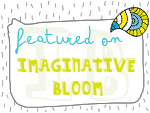|
|
By Irene Zuccarello, on January 17th, 2015
*note: this post is about a contest for italian bloggers*
Come vi avevo promesso qualche giorno fa dalla bacheca della mia pagina Facebook, eccomi per parlarvi dello speciale concorso che la rivista CasaFacile ha lanciato per tutti i blogger appassionati di craft/grafica o interni/design.
CF collabora già con una squadra di blogger con i quali negli anni si sono instaurati rapporti di scambio e collaborazione vivaci ed interessanti (tra questi ci sono anche io - eccoci qui sotto nel numero di Gennaio).
 (Foto credit: CasaFacile) (Foto credit: CasaFacile)
Se non conoscete i blogger che già collaborano con CF e siete curiosi, potete sbirciare tra i link della lista in ordine alfabetico che vi lascio qui sotto:
La ‘casa’ continua a crescere e non vede l’ora di far entrare nuovi appassionati blogger nella squadra. Uno dei prossimi Blogger CF Style potresti essere tu!
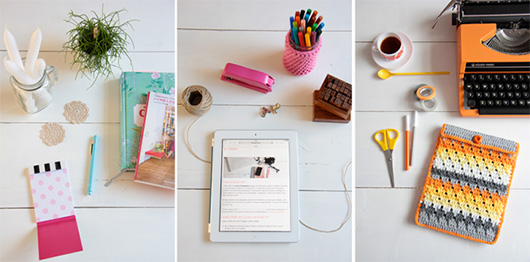 (Foto credit: Ilaria Chiaratti) (Foto credit: Ilaria Chiaratti)
Di seguito scrivo tutti i link che ti servono per trovare le informazioni per partecipare al concorso, incluse le specifiche per essere ammessi (puoi candidarti entro il 17 Febbraio) più una serie di link alle lezioni gratuite che CasaFacile ha preparato assieme alle ragazze del Il Blog Lab per aiutarti a presentare al meglio il tuo blog.
- Come partecipare e candidarsi
- Regolamento completo
LEZIONI PER AIUTARTI A PERFEZIONARE IL TUO BLOG
(i link verranno aggiornati settimanalmente con le nuove lezioni pubblicate)
1. Uso delle piattaforme Blogger e WordPress con dominio proprietario (7 gennaio)
2. Cenni di grafica e immagine coordinata (9 gennaio)
3. Scrivere e programmare i post secondo un calendario editoriale (14 gennaio)
4. Cenni di fotografia e styling (16 gennaio)
5. Cercare l’ispirazione e trovare un’identità (21 gennaio)
6. Promuovere il blog attraverso i social network (23 gennaio)
7. Creare un media kit (28 gennaio)
8. Analizzare le statistiche del blog e dei social network (30 gennaio)
Se questa è la tua passione non perdere questa bellissima opportunità!
Buon lavoro e in bocca al lupo!!! :)
By Irene Zuccarello, on January 1st, 2013
EnglishYaY! It’s the first day of 2013 and I can say I started the new year creating! I like the feeling!
Thanks to Mayi Carles of Heartmade blog for asking me to be part of her “I’m Messy and I Know it” Day – immediately loved the theme and the idea to be part of a community of messy creatives!
I took this opportunity also to experiment and have fun hand painting on fabric and embroidering little details.
One of my goals for this year is to create a collection of handmade products available for purchase and Tea Towels are a project I have in mind for a while.
This is my contribution to Mayi’s party.
I LOVE tea towels, and you? :)

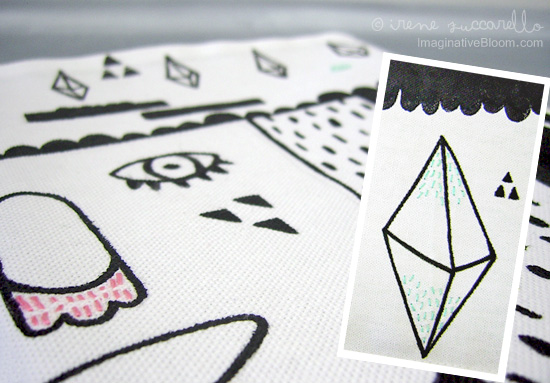
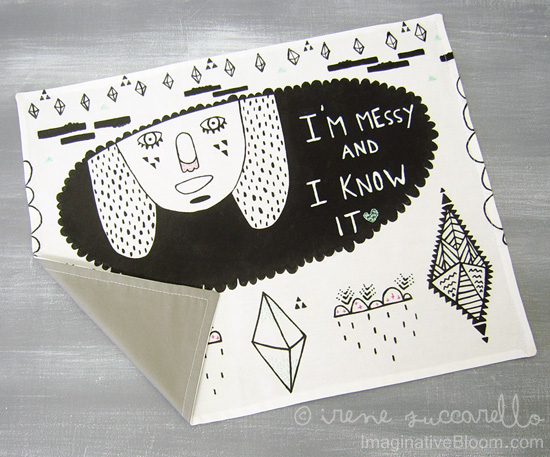

If you want to know more about “I’m Messy and I Know it” Day go here.
I also suggest to take a look at Mayi’s Life is Messy Bootcamp – an amazing program truly made with love and passion to help messy creatives and bloggers (like me) to fight against the mania of perfectionism and boost the productivity thermometer + a lot of AMAZINGLY useful Planners!
Mayi is really GREAT on this! Luv.
ItalianoYeeee! E’ il primo giorno del 2013 e posso dire di aver iniziato il nuovo anno creando! Che bella sensazione!
Grazie a Mayi Carles di Heartmade blog per avermi chiesto di essere parte del suo “I’m Messy and I Know it” Day – il tema mi ha conquistata subito e pure l’idea di essere parte di una comunità di “creativi disordinati” – rientro nella categoria alla grande!
E in più ho colto l’occasione per sperimentare e divertirmi un po’ con la pittura su stoffa e il ricamo di piccoli dettagli.
Uno dei miei obiettivi quest’anno è quello di creare una collezione di prodotti handmade acquistabili, e le tovagliette da thè sono un progetto che ho in mente da tempo.
Questa che vedete qui sotto è il mio contributo al “Party” virtuale di Mayi.
Io AMO le tovagliette da thè, voi? :)




Se volete saperne di più del “I’m Messy and I Know it” Day andate qui.
Vi suggerisco anche di dare uno sguardo al Life is Messy Bootcamp di Mayi – un interessante programma fatto col cuore e con vera passione per aiutare creativi e blogger incasinati (come me) a combattere le manie di perfezionismo e a far schizzare in alto il termometro della produttività + un bel malloppo di Planners fantasticamente utili!
Mayi in questo è davvero davvero IN GAMBA! Love.
By Irene Zuccarello, on October 9th, 2012
EnglishFinally, with a little bit of emotion, I can share it with you!
I’ve been invited as blogger at the “Meet The Blogger“ event by Casa Facile Italian magazine at Abilmente fiera, the famous international fair of manual creativity that takes palce every year in Vicenza, Italy.
Needless to say that it’s an honor for me (and an unexpected surprise!) to have been chosen to talk about my personal experience together with other great bloggers.
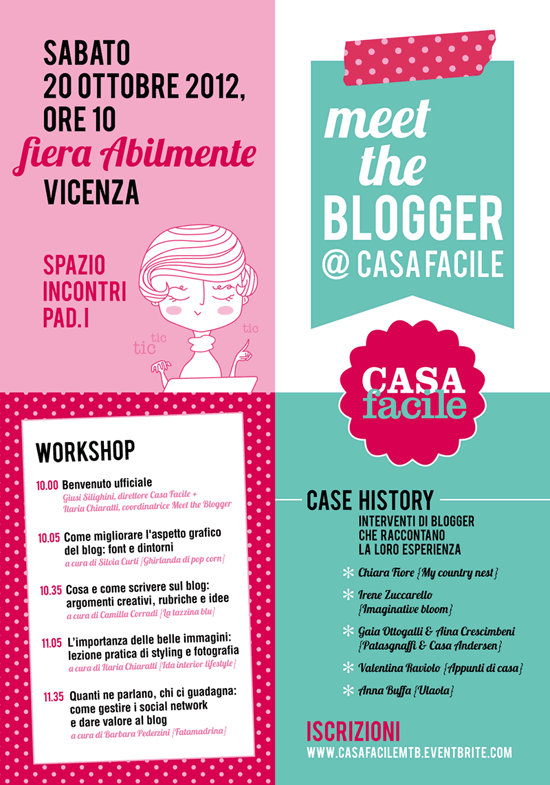
As you can see from the image above and from the magazine, the event will take place on October 20; there will be some interesting workshops (how to improve the graphic aspect of your blog, how and what to write, photography and styling, how to use social networks to valorise your blog, etc) and the bloggers invited will talk about their own experience.
Those who know me also know how I’m shy, so for me this will be a challenge.
Well… hope not to make too many gaffes! :D
To join the event you have to subscribe – although it seems that all the seats are sold out in 48 hours!!!
But don’t give up! As the event on Facebook says, after the “Meet the Blogger” moment in the morning, <<in the afternoon (3 P.M. at stand 181, tent F) we will be at the CasaFacile stand to keep on chatting and sharing experiences and ideas – no limits of seats!
Cant wait to meet in person the people that until now I knew only virtually.
If you’ll be at Abilmente, come to say hello! :)
________________________________________________________
Here’s the links to all the bloggers invited:
Silvia Curti - Ghirlanda di Pop Corn
Camilla Corradi - La Tazzina Blu
Ilaria Chiaratti - Ida Interior Lifestyle
Barbara Pederzini - Fatamadrina
Chiara Fiore - My Country Nest
Irene Zuccarello (me) – Imaginative Bloom
Gaia Ottogalli e Aina Crescimbeni – Patasgnaffi e Casa Andersen
Valentina Raviolo – Appunti di Casa
Anna Buffa – Ulaola
ItalianoFinalmente, con la voce un po’ emozionata, posso condividerlo con voi!
Sono stata invitata come blogger all’evento “Meet The Blogger“ organizzato dalla rivista Casa Facile all’interno di Abilmente fiera, la famosa Mostra-atelier Internazionale della Manualità Creativa, che si svolge ogni anno a Vicenza!
Inutile dire che per me è un onore (e una sorpresa totalmente inaspettata!) essere stata scelta per parlare della mia personale esperienza assieme ad altre bravissime blogger che si sono affermate nel web; molte sono già riuscite a far diventare la loro passione un lavoro.

Come potete leggere dal poster e come annunciato nel numero di Ottobre della rivista, il tutto si svolgerà sabato 20, e sarà composto di vari momenti, tra cui una serie di interessanti workshop e gli interventi dei blogger invitati.
Chi mi conosce sa quanto io sia timida, perciò per me questa sarà una bella sfida.
Che dire… speriamo di non fare troppe gaffes! :D
Per partecipare all’ evento ci si deve iscrivere – anche se a quanto pare i posti si sono esauriti nel giro di 48 ore!!
Ma non demordete, perché come riporta l’aggiornamento dell’evento su Facebook, dopo la mattinata con il “Meet the Blogger” allo spazio incontri pad.I, <<nel pomeriggio saremo tutti (relatori e redazione) presso lo stand di CasaFacile per continuare in libertà tra chiacchiere e condivisioni di idee ed esperienze.
L’ appuntamento consolatorio è alle 15, stand 181, pad.F … senza iscrizione, ma fino a esaurimento metriquadrati!>>
Non vedo l’ora di conoscere di persona chi conosco ancora solo virtualmente.
Se siete ad Abilmente, passate a salutarmi! :)
________________________________________________________
Vi lascio la lista e i links di tutti i blogger che interverranno:
Silvia Curti - Ghirlanda di Pop Corn
Camilla Corradi - La Tazzina Blu
Ilaria Chiaratti - Ida Interior Lifestyle
Barbara Pederzini - Fatamadrina
Chiara Fiore - My Country Nest
Irene Zuccarello (me) – Imaginative Bloom
Gaia Ottogalli e Aina Crescimbeni – Patasgnaffi e Casa Andersen
Valentina Raviolo – Appunti di Casa
Anna Buffa – Ulaola
By Irene Zuccarello, on December 9th, 2011
EnglishAfter about a hundred of projects sent to the UnDoToDo contest and the hard work of the whole team who organized it, the winners have been announced.
And Imaginative Bloom as a media partner of this interesting contest, is happy to share with you the winning projects!
▲▲▲▲▲
The 3rd prize has been won by Cecilia Felli with her original Umbrella Skirt project.
Probably my fav! But I suppose I may be biased, it’s a “girly” thing, and you can also wear it!
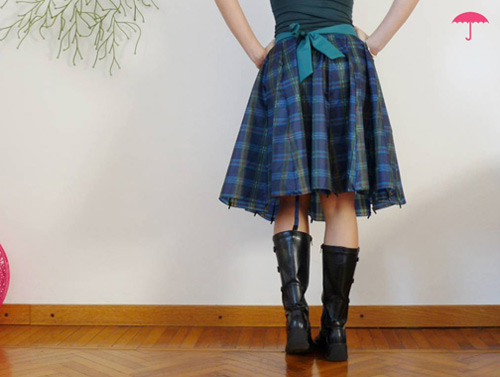
The 2nd prize is for Raffaele De Martino with his “Stecca” project, to hang clothes on the wall.
Football fans will love it. Well I’m not one of them, but this idea of design through recycling is really original.
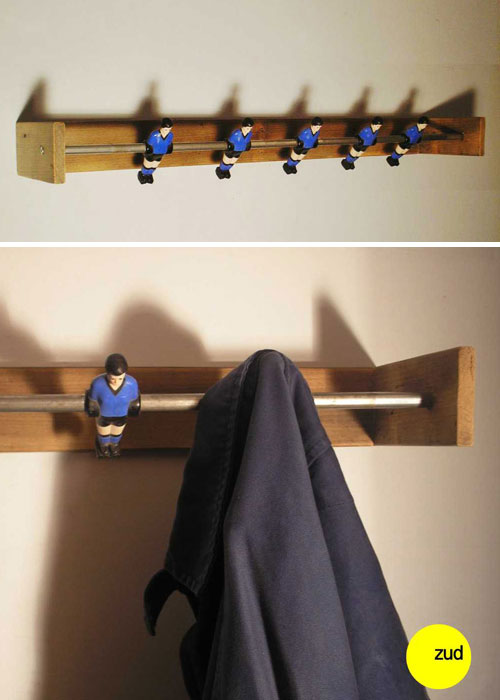
And the 1st prize go to Roberto Volpe with the project Bike Park.
Genius and simple idea together. I’d love to see the city full of these!

Three original projects born from a mix of handmade and design.
If you want to know more about the future initiatives promoted by IndieUp, connect with them :)
ItalianoDopo più di un centianio di progetti pervenuti al UnDoToDo contest e il duro lavoro dell’intero team che l’ha seguito, finalmente ci sono i nomi dei vincitori.
E Imaginative Bloom, in qualità di Media Partner di questo interessante contest, è felice di condividere con voi i progetti che hanno vinto!
▲▲▲▲▲
Il terzo premio è stato vinto da Cecilia Felli con il suo originale progetto Umbrella Skirt.
Probabilmente il mio preferito! Ma temo di essere di parte, è una cosa da ragazze, e si indossa pure!

Il secondo premio è per is Raffaele De Martino con il suo progetto “Stecca“, per appendere gli abiti al muro.
Gli amanti del calcio lo ameranno. Non sono fra questi, ma questa idea di design attraverso il recupero è davvero originale.

E il primo premio va a Roberto Volpe col progetto Bike Park.
Idea semplice ma geniale. Mi piacerebbe vederne la città piena.

Tre progetti originali nati da un mix di handmade e design.
Se volete essere aggiornati sulle future iniziative promosse da IndieUp, fate un salto nel loro sito :)
By Irene Zuccarello, on April 20th, 2011
English
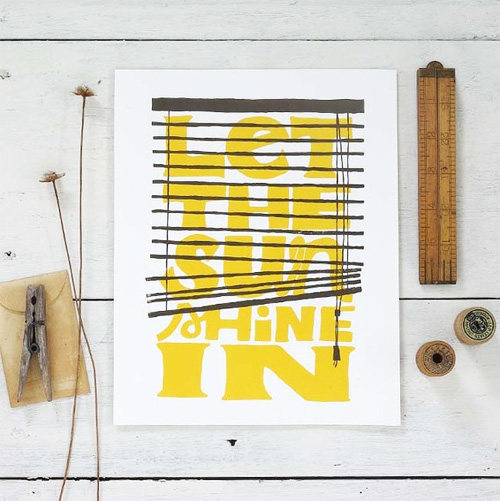 Silk screen printed poster – Let the sun shine in by Slide Sideways on Etsy Silk screen printed poster – Let the sun shine in by Slide Sideways on Etsy
All creative entrepreneurs experience the ebb and flow of sales. Some weeks and months are better than others.
If you hit a slow patch and your sales come to a halt, panic can take over. Instead of panicking, use this time wisely and you’ll see your sales increase before you know it.
Here are 8 productive things you can do in this downtime:
1. Find another revenue stream.
You should have more than one revenue stream in case your sales slow down, so brainstorm ways that you can add another revenue stream now. If you already sell on Etsy, you might apply to a local craft show.
If you already do both of those things, you could approach a local boutique about carrying your products. If you teach local knitting classes, you might consider teaching online classes. Do something different.
2. Stock up on products.
If you’ve ever had those moments where you don’t know if you’ll be able to produce and ship all of your orders on time, you should consider stocking up on your products. Then, when your sales pick back up, you’ll be ready for it.
3. Connect with your customers.
We get busy and we forget about stuff—including our favorite handmade businesses. So, you could take this time to remind your customers that you’re around.
This might mean sending your customers postcards with a small discount code or sending out an email newsletter with some shop updates.
4. Improve your product photos.
We can all improve our product photos, and spending your downtime on this task is a great investment in your time. When you improve your photos, your chance of increasing your sales sky rockets.
5. Improve your product descriptions.
After you’ve worked on your product photos and you think they’re magazine-worthy, you should also look over your product descriptions.
Have you answered all the questions that your potential customers might have before they purchase?
Have you described the product clearly? Have you included bits of story in your descriptions?
For instance, have you included a few sentences about the inspiration behind the product?
6. Get ahead on your blog posts.
If you’re blogging for your creative biz, you could spend some time writing and scheduling blog posts for the next couple weeks. When your sales increase, you won’t have to worry about blogging and you can focus on making and shipping your products.
7. Connect and promote your business on social media.
If you’re not having much luck with sales, you probably don’t want to spend a ton of money on advertising. Instead, you can promote your business on social media for free.
Connect with your target market on Facebook and Twitter. Ask them questions and start conversations.
8. Look for ways you can expand your product line.
For example, if you sell handmade aprons, you might consider adding a line of matching dish towels and oven mitts to give your customers more options.
Don’t allow your inner critic to take over during this downtime. You’re in control of your creative business destiny, so use your time wisely and try to stay positive.
________________________________________________________
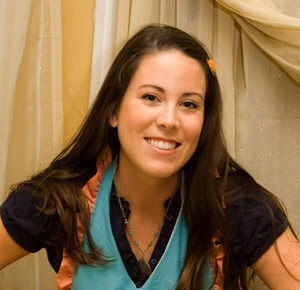 About April About April
April Bowles-Olin helps creative entrepreneurs turn their dreams into reality through her website, Blacksburg Belle, where she writes about marketing, blogging, and increasing business success. She uses her background in psychology to help creatives reach their goals, take charge of their inner critic, and build businesses around their dream lifestyles.
Italiano Silk screen printed poster – Let the sun shine in by Slide Sideways in Etsy Silk screen printed poster – Let the sun shine in by Slide Sideways in Etsy
8 Suggerimenti per usare saggiamente il tuo momento di “down”
Ogni imprenditore creativo sperimenta il flusso e riflusso delle vendite. Alcune settimane e mesi sono migliori di altri.
Se stai vivendo un rallentamento e le vendite si fermano, il panico può prendere il sopravvento. Invece di impanicarti, usa questo tempo con saggezza e vedrai le tue vendite aumentare prima ancora di rendertene conto.
Qui ci sono 8 cose produttive che puoi fare in questo periodo di “down”:
1. Trovare un’altro flusso di entrate.
Dovresti avere più di un flusso di entrate nel caso in cui le vendite diminuiscano, perciò rifletti, fai un brainstorm (butta giù un pò di idee), sui modi in cui puoi aggiungere ora un’altro flusso di entrate. Se vendi già in Etsy, potresti partecipare ad una mostra di artigianato locale.
Se fai già entrambe le cose, potresti proporre a una boutique locale di tenere i tuoi prodotti. Se dai lezioni di uncinetto nella tua città, potresti considerare di fare delle lezioni online. Fa qualcosa di diverso.
2. Fare la scorta di prodotti.
Se ti sei già trovato in uno di quei momenti in cui non sai se sarai in grado di produrre e spedire tutti I tuoi ordini in tempo, dovresti prendere in considerazione l’idea di prepararti una scorta di prodotti. Così, quando le tue vendite riprenderanno, sarai pronto.
3. Connetterti coi tuoi clienti.
Siamo sempre indaffarati e ci dimentichiamo di un sacco di cose – comprese le piccole imprese artigianali creative che adoriamo. Perciò, potresti usare questo tempo per ricordare ai tuoi clienti che ci sei.
Questo può significare spedire ai tuoi clienti delle cartoline con un piccolo codice sconto o spedire una spedire una newslettervia email con qualche aggiornamento sul tuo shop.
4. Migliorare le foto dei tuoi prodotti.
Tutti possiamo migliorare le foto dei nostri prodotti, e impiegare il tuo periodo di “down” nelle vendite in questo compito è un grande investimento del tuo tempo. Quando migliori le tue foto, la possibilità di aumentare le vendite va alle stelle.
5. Migliorare le descrizioni dei tuoi prodotti.
Dopo che hai lavorato sulle foto dei tuoi prodotti e pensi che siano diventate degne di una rivista, potresti anche dare uno sguardo alle descrizioni dei tuoi prodotti.
Hai risposto a tutte le domande che i tuoi potenziali clienti potrebbero avere prima di acquistare?
Hai descritto il prodotto chiaramente? Hai incluso un pò di “storia” nelle tue descrizioni?
Per esempio, hai inserito qualche frase sull’ispirazione che sta dietro alla creazione del prodotto?
6. Andare avanti coi tuoi articoli nel blog.
Se stai bloggando per il tuo business creativo, potresti spendere del tempo scrivendo e programmando degli articoli per le prossime settimane. Quando le tue vendite cresceranno, non dovrai preoccuparti troppo del blog e potrai focalizzarti a fare e spedire i tuoi prodotti.
7. Connettere e promuovere la tua attività sui social media.
Se non stai avendo molta fortuna con le vendite, probabilmente non vorrai spendere una valanga di soldi in pubblicità. Puoi però promuovere la tua attività nei social media gratuitamente.
Connettiti col tuo target di mercato in Facebook e Twitter. Fai delle domande e inizia delle conversazioni.
8. Cercare dei modi per espandere la tua linea di prodotti.
Per esempio, se vendi grembiuli fatti a mano, potresti considerare di aggiungere una linea di tovaglioli e guanti da cucina abbinata per dare ai tuoi clienti più opzioni.
Non permettere al tuo senso critico interiore di prendere il sopravvento nel periodo di down. Sei tu che hai il controllo sul destino della tua attività creativa, perciò us ail tuo tempo con saggezza e cerca di restare positivo.
________________________________________________________
 Chi è April Chi è April
April Bowles-Olin aiuta gli imprenditori creativi a far diventare i loro sogni realtà attraverso il suo sito, Blacksburg Belle, dove scrive di marketing, blogging, e di come aumentare il successo della vostra attività. Usa il suo background in psicologia per aiutare i creativi a raggiungere i loro obiettivi, a prendere atto del loro senso critico, e costruire un’attività plasmata sullo stile di vita che sognano.
By Irene Zuccarello, on April 13th, 2011
English
 1. Keep Calm and Tweet On Poster by queensspoof | 2. Birdie ring by sculleydesign | 3. Follow Me Twitter Tattoo thigh-high stockings by post | 4. Hand Printed Lino Bird Card / Notelet by Vickyday {via Etsy} 1. Keep Calm and Tweet On Poster by queensspoof | 2. Birdie ring by sculleydesign | 3. Follow Me Twitter Tattoo thigh-high stockings by post | 4. Hand Printed Lino Bird Card / Notelet by Vickyday {via Etsy}
Do you want to get new customers? Do you want to develop relationships with current customers to increase the likelihood that they’ll become repeat customers? Do you want to increase your sales?
If you said yes to those three questions, you want to be on Twitter. Why?
- It’s free.
- You only get 140 characters per tweet, so it doesn’t take a lot of time to engage.
- Some of your customers are already on Twitter, and you want to be involved in the conversation.
If you use Twitter in a non-spammy way, you can increase your creative business sales. Here are 10 tips to do just that:
1. Be yourself.
Anywhere you’re promoting your creative business you want your personality to shine. That’s what sets you apart from everyone else. It’s also what will draw people to you. People buy from people and businesses that they know, like, and trust. Give your followers a chance to get to know, like, and trust you.
2. Don’t use Twitter as an RSS feed. Don’t over-promote yourself and your business.
If you only get on Twitter to promote your blog posts, products, and services, you’re doing it wrong. If you send out a tweet every time you upload a new product on Etsy, you’re doing it wrong. It’s called social media for a reason—you’re supposed to be social. I suggest looking at your last 20 tweets and counting how many fall into the self-promotional category and how many fall into the relationship-building category. Out of 20, about 15-17 should fall into the relationship-building category.
3. Don’t under-promote yourself and your business.
When you looked at your last 20 tweets, did you have 2-5 self-promotional tweets? If not, you might need to promote your stuff a little more. The people who follow you do want to know about your stuff. They want to know when you publish a thoughtful blog post, when you launch a new line of products, or when you’re having a sale. Just don’t overdo it.
4. Engage. Be social.
When someone sends you a tweet, respond to it. Talk to your followers and the people you’re following. Start conversations, and build relationships.
5. Ask questions. Answer questions.
You can get to know your target market really well on Twitter by asking questions. For instance, when you’re about to launch a new product line, you could ask for opinions and feedback. Then, you could make changes to your product to make it a better match for your target market.
Also, be helpful to others by answering questions.
6. Be patient.
It takes time to grow a group of followers who care about what you have to say. And, it’s not about numbers. You’ll be much more successful on Twitter with 100 loyal followers than with 1,000 followers who don’t really care about you or your business. So, don’t buy into any of those “get 10,000 followers in a week” scams.
7. Don’t complain all the time.
Some people seem to use Twitter as a way to vent and complain. I don’t know about you, but I don’t like being around someone who never has anything good to say. That goes for online and offline.
If you’re using Twitter as a marketing tool, do you really want your business associated with all that negativity?
8. Think of it as a way to chat with your coworkers.
This tip comes from the lovely Jessica Swift.
If you work from home or work alone, think of Twitter as a way to chat with people who you’d chat with at work. You can bounce ideas off of each other, catch up, and build relationships that can lead to big things that’ll help your creative business.
9. Take chances.
Don’t be afraid to attempt to engage people that you admire. They might be too bombarded with tweets to answer every one, but they probably read them all. If you keep trying, you’ll have a much better chance than someone who doesn’t try.
10. Have a plan.
You don’t want Twitter to take over your life. You don’t want to waste hours on social media and not get the really important stuff done—like actually making products to sell. Decide how much time you’re going to spend and try to stick to it.
When I check something off of my to-do list for the day, I usually set a timer for 10 or 15 minutes, get up and stretch or dance around, respond to emails, and hop on Twitter. When the timer goes off, it’s back to work and Twitter is closed.
Use these 10 tips to increase the likelihood of creative business success from using Twitter.
________________________________________________________
 About April About April
April Bowles-Olin helps creative entrepreneurs turn their dreams into reality through her website, Blacksburg Belle, where she writes about marketing, blogging, and increasing business success. She uses her background in psychology to help creatives reach their goals, take charge of their inner critic, and build businesses around their dream lifestyles.
Italiano
 1. Keep Calm and Tweet On Poster by queensspoof | 2. Birdie ring by sculleydesign | 3. Follow Me Twitter Tattoo thigh-high stockings by post | 4. Hand Printed Lino Bird Card / Notelet by Vickyday on Etsy {via Etsy} 1. Keep Calm and Tweet On Poster by queensspoof | 2. Birdie ring by sculleydesign | 3. Follow Me Twitter Tattoo thigh-high stockings by post | 4. Hand Printed Lino Bird Card / Notelet by Vickyday on Etsy {via Etsy}
Vuoi avere nuovi clienti? Vuoi sviluppare dei rapporti con gli attuali clienti per aumentare la probabilità che diventino abituali? Vuoi aumentare le tue vendite?
Se hai risposto si a queste tre domande, vuoi stare su Twitter. Perché?
- E’ gratuito.
- Hai solo 140 caratteri per tweet, perciò non richiede molto tempo.
- Alcuni dei tuoi clienti sono già su Twitter, e tu vuoi essere coinvolto nella conversazione.
Se usi Twitter in un modo non-spammoso, puoi aumentare le vendite del tuo business creativo. Qui ci sono 10 suggerimenti per fare proprio questo:
1. Sii te stesso.
Ovunque tu stia promuovendo il tuo business creativo vuoi che la tua personalità risplenda. Questo è ciò che ti distingue da chiunque altro. E’ anche ciò che attirerà le persone a te. Le persone acquistano da persone e aziende che conoscono, che gli piacciono e di cui hanno fiducia. Dai ai tuoi followers/chi ti segue la possibilità di conoscerti, di piacergli e di avere fiducia in te.
2. Non usare Twitter come un RSS feed. Non promuovere troppo te stesso e il tuo business.
Se sei su Twitter per promuovere i posts del tuo blog, i tuoi prodotti e servizi, stai sbagliando. Se invii un tweet ogni volta che carichi un nuovo prodotto in Etsy, stai sbagliando. Si chiama Social Media per un ragione – dovresti essere sociale. Suggerisco di guardare i tuoi ultimi 20 tweets e di contare quanti rientrano nella categoria auto-promozione e quanti rientrano nella categoria costruzione-relazioni. Su 20, 15-17 dovrebbero rientrare nella categoria della costruzione di relazioni.
3. Non promuovere troppo poco te stesso e il tuo business.
Quando hai guardato i tuoi ultimi 20 tweets, hai trovato 2-5 tweets auto-promozionali? Se non è così, potresti aver bisogno di promuovere le tue creazioni un pò di più. Le persone che ti seguono sono interessate ai tuoi prodotti. Vogliono sapere quando pubblichi un post che fa riflettere, quando lanci una nuova linea di prodotti, o quando fai dei saldi. Basta non esagerare.
4. Impegnati. Sii sociale.
Quando qualcuno ti invia un tweet, rispondigli. Parla a chi ti segue e alle persone che stai seguendo. Inizia delle conversazioni, costruisci relazioni.
5. Fai domande. Rispondi alle domande.
Puoi conoscere il tuo target di mercato molto bene su Twitter facendo domande. Per esempio, quando stai lanciando una nuova linea di prodotti, potresti chiedere opinioni e feedbacks. Poi, puoi fare dei cambiamenti al tuo prodotto per renderlo una combinazione migliore per il tuo target di mercato.
Inoltre, sii utile agli altri rispondendo alle domande.
6. Sii paziente.
Ci vuole tempo per crescere un gruppo di followers (“seguaci”) a cui importa quello che hai da dire. E non si tratta di numeri. Avrai molto più successo su Twitter con 100 leali followers che con 1,000 followers a cui non importa davvero di te e del tuo business. Quindi non acquistare una di quelle truffe del tipo “ottieni 10,000 followers in una settimana”.
7. Non lamentarti tutto il tempo.
Alcune persone sembrano usare Twitter come un modo per sfogarsi e lamentarsi. Non ti conosco ma non mi piace stare attorno a persone che non hanno mai nulla di buono da dire. Questo sia online che offline.
Se stai usando Twitter come strumento di marketing, vuoi davvero il tuo business associato a tutta questa negatività?
8. Pensa ad esso come ad un modo per chattare coi tuoi colleghi.
Questo suggerimento viene dall’ adorabile Jessica Swift.
Se lavori da casa o lavori da solo, pensa a Twitter come a un modo per chiacchierare con le persone con cui parleresti al lavoro. Puoi far rimbalzare le idee degli altri, recuperare e costruire relazioni che possono portarti a grandi cose che aiuteranno il tuo business creativo.
9. Prendi le opportunità.
Non avere paura di provare a coinvolgere le persone che ammiri. Potrebbero essere bombardate da tweets e non riuscire a rispondere a ognuno, ma probabilmente li leggono tutti. Se continui a provare, avrai più probabilità di coloro che non provano.
10. Pensa a un piano.
Non vuoi che Twitter ti prenda la vita. Non vuoi perdere ore sui ocial media e finire per non aver fatto le cose davvero importanti – come realizzare i prodotti da vendere. Decidi quanto tempo spenderai e cerca di attenerti ad esso.
Quando controllo qualcosa al di fuori della mia to-do-list del giorno (lista delle cose da fare), di solito imposto un timer per 10-15 minuti, mi alzo, facio un pò di stretching o ballo, rispondo alle emails e vado su Twitter. Quando il timer si spegne, si torna al lavoro e Twitter viene chiuso.
Usa questi 10 suggerimenti per aumentare la probabilità di successo col tuo business creativo usando Twitter.
________________________________________________________
 Chi è April Chi è April
April Bowles-Olin aiuta gli imprenditori creativi a far diventare i loro sogni realtà attraverso il suo sito, Blacksburg Belle, dove scrive di marketing, blogging, e di come aumentare il successo della vostra attività. Usa il suo background in psicologia per aiutare i creativi a raggiungere i loro obiettivi, a prendere atto del loro senso critico, e costruire un’attività plasmata sullo stile di vita che sognano.
By Irene Zuccarello, on April 6th, 2011
English
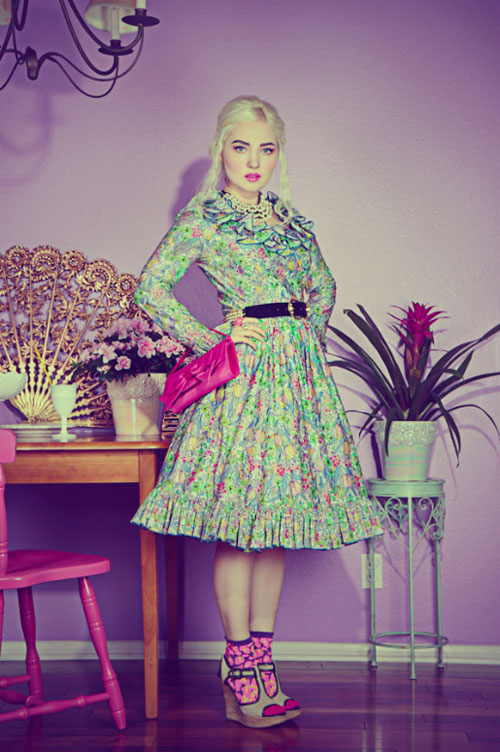 Photo via Doe Deere Blogazine.com Photo via Doe Deere Blogazine.com
Do you want to know one of the most popular questions I get asked over and over? Well, here it is:
Why isn’t my blog working?
Often, this question means why don’t I have engaged readers, why don’t people leave me comments, why don’t people care what I have to say, and why don’t my readers buy from me.
There are many reasons that your blog might not be “working” such as: you don’t blog for your target market, your blog looks like a hot mess, you haven’t been blogging for very long, you forget to blog for months at time, you don’t provide your readership with valuable information. But, the reason I’m gonna talk about today is this: it’s not business—it’s personal.
It’s Not Business—It’s Personal
Too often, creative entrepreneurs start personal blogs, and then they expect those blogs to help them make more sales. They want their readers to buy from them. This is a recipe for disappointment. Unless you have a highly entertaining and popular personal blog, you’re not going to increase your creative business success with it.
I want to be very clear: there is nothing wrong with having a personal blog. A couple of my favorite bloggers fall into this category—but if you really want your blog to help you reach creative biz success, your personal blog probably won’t help much. And, the reason is the people who enjoy reading your personal blog are probably not interested in buying your handmade wedding cake toppers. However, if you blog about things related to weddings, your readers are much more likely to be interested in your products.
Here are the main differences between personal and creative business blogs:
1. Personal blogs cover any topic the blogger is thinking about or experiencing at that time. For instance the blogger might post about her hardcore, no-nonsense personal trainer, the recipe for meatloaf that her family loves, and the red polka-dotted rain boots she recently bought.
Creative business blogs mainly stick to the topic at hand. If you sell knitting patterns and have a creative business blog, you probably wouldn’t write an entire post about your cat. Unless, you have a funny story of how your cat unraveled your last knitting project when you were taking a bubble bath. You probably stick to knitting tips and tricks, video tutorials, posts on basic knitting techniques, and posts on how to read and use knitting patterns. You understand that your readers don’t really care about your flat tire or the hot guy sitting next to you on your trip to Alaska.
2. Personal bloggers blog when they have something to say. This could mean that the persons posts for five days in a row and then doesn’t post again for a couple weeks.
Creative business bloggers often to stick to a schedule such as posting once or twice a week.
3. Personal blogs often look personal—not professional. This isn’t always the case. But, often it is. The blogger doesn’t match her blog to her creative business brand or put a lot of time and effort in the design of the site.
And, creative business bloggers should spend time and effort on the design of their sites. Why? Because, they want people to buy from them, so their sites need to have a professional feel. When I say professional, I don’t mean stiff and stuffy. You can have a professional site filled with color and personality. Check out Jessica Swift’s website and blog for a great example of this.
The Two Can and Should Meld Together
I always encourage creative entrepreneurs to sprinkle story throughout their posts. This is super important for connecting with your readers. But, the personal stuff should have a purpose. For example, if you sell and blog about mixed media art, you might tell the story of how you found a box of vintage postcards in your grandmother’s attic, because you use them in many pieces of your art.
If you sell vegan baked goods and blog about all things vegan, you could tell the story of why you became vegan, the story of how you started a baking business, or the story of recently adopting a new dog from your local shelter. Your readers will be interested in those things.
So, don’t leave out personal stuff. Instead, choose it wisely.
Personal versus Personality
It’s important to know that I’m not encouraging anyone to leave out their personality. Your business and blog should be built around your personality. If you’re obsessed with the color teal, use it. If you read an amazing book that’s inspiring your art, write about it. If your favorite flavor of ice-cream is mint chocolate chip, include this fun tidbit on your about page.
You want your blog to reflect who you are and what you’re passionate about, but you also want it to connect with your target market. And, that means writing for your target market—not writing about just anything that comes to mind.
________________________________________________________
 About April About April
April Bowles-Olin helps creative entrepreneurs turn their dreams into reality through her website, Blacksburg Belle, where she writes about marketing, blogging, and increasing business success. She uses her background in psychology to help creatives reach their goals, take charge of their inner critic, and build businesses around their dream lifestyles. April fell in love with art the day her mother handed her a box of brightly colored crayons, and believes that living your truth, creating daily, and loving fully leads to happiness.
Italiano
 Foto via Doe Deere Blogazine.com Foto via Doe Deere Blogazine.com
Vuoi sapere qual è una delle domande che mi viene fatta continuamente? Bene, eccola:
Perché il mio blog non sta funzionando?
Spesso, questa domanda significa perché non attira lettori, perché le persone non mi lasciano commenti, perché alle persone non interessa quello che ho da dire, e perché i miei lettori non acquistano da me.
Ci sono molte ragioni per cui il tuo blog potrebbe “non funzionare” come: non scrivi per il tuo target di mercato, il tuo blog sembra un gran casino, non hai scritto per molto tempo, ti dimentichi di scrivere da mesi, non fornisci ai tuoi lettori informazioni di valore. Ma, la ragione di cui ti parlerò oggi è questa: non è per il “business” – è un blog personale.
Non è per il business – è personale
Troppo spesso, gli imprenditori creativi aprono dei blogs personali e poi si aspettano che questi blogs li aiutino a fare più vendite. Vogliono che i lettori acquistino da loro. Questa è la ricetta per la delusione. A meno che tu non abbia un blog personale che è particolarmente divertente/di intrattenimento e famoso, non aumenterai il tuo business creativo con esso.
Voglio essere motlo chiara: non c’è nulla di sbagliato nell’avere un blog personale. Un paio dei miei bloggers preferiti rientrano in questa categoria – ma se vuoi davvero che il tuo blog ti aiuti a raggiungere successo nel tuo business creativo, il tuo blog personale probabilmente non ti aiuterà molto. E il motivo è che le persone che si divertono a leggere il tuo blog personale probabilmente non sono interessati ad acquistare i tuoi cake toppers artigianali. Tuttavia, se scrivi di argomenti collegati ai matrimoni, sarà molto più probabile che i tuoi lettori siano più interessati ai tuoi prodotti.
Le principali differenze tra i blogs personali e quelli finalizzati ad un business:
1. I blogs personali trattano qualunque argomento a cui il blogger pensa e che sperimenta in quel momento. Per esempio può scrivere dei suoi fatti personali, cose senza senso sul suo personal trainer, la ricetta del polpettone che piace tanto alla tua famiglia, e gli stivali da pioggia a pois rossi che ha comprato di recente.
I blogs finalizzati ad un business si attengono principalmente ad un argomento. Se vendi patterns/schemi per dei lavori all’uncinetto e hai un blog per il tuo business, probabilmente non scriveresti un intero post sul tuo gatto. A meno che tu non abbia una storia divertente su come il tuo gatto ha disfato il tuo ultimo progetto ad uncinetto mentre ti stavi facendo un bagno. Probabilmente tratteresti di suggerimenti e consigli sul lavoro ad uncinetto, video tutorials, articoli sulle tecniche base e su come leggere e usare gli schemi per uncinetto. Capisci che ai tuoi lettori non importa davvero del tuo pneumatico sgonfio o del fantastico ragazzo che sedeva accanto a te durante il tuo viaggio in Alaska.
2. Coloro che possiedono un blog personale, scrivono quando hanno qualcosa da dire. Questo potrebbe significare che scrivono di getto per 5 giorni di seguito e che poi non postano nulla per un paio di settimane.
I bloggers dei blog creativi finalizzati ad un business spesso si attengono ad un programma, come il postare una o due volte la settimana.
3. I blogs personali spesso sembrano personali – non professionali. Non è sempre così, ma spesso lo è. Il bogger non abbina il suo blog al brand/marchio del suo business creativo e non mette troppo tempo ed impegno nel design del sito.
E i bloggers di un blog creativo finalizzato ad un business dovrebbero spendere tempo ed impegno nel design dei loro siti. Perché? Perché vogliono che le persone acquistino da loro, perciò i loro siti necessitano di avere un look professionale. Quando dico professionale, non intendo rigido e soffocante. Puoi avere un sito professionale riempito di colori e personalità. Guarda il sito e blog di Jessica Swift’s per avere un esempio.
I due possono e dovrebbero fondersi
Incoraggio sempre gli imprenditori creativi a cospargere di storie i loro posts. Questo è super importante per connetterti ai tuoi lettori. Ma il materiale personale dovrebbe avere uno scopo. Per esempio, se vendi e scrivi di mixed media art, potresti raccontare la storia di come hai trovato una scatola di vecchie cartoline nell’attico di tua nonna, perché le usi in molte tue creazioni artistiche.
Se vendi prodotti da forno vegani e scrivi di tutte cose inerenti al vegano, potresti raccontare la storia del perché sei diventato vegano, la storia di come hai iniziato un business proprio su questo, o la storia di aver adottato recentemente un nuovo cane dal rifugio locale. I tuoi lettori saranno interessati a queste cose.
Perciò non lasciare fuori le tue cose personali. Piuttosto, sceglile con cura.
Personale contro Personalità
E’ importante che si sappia che non sto incoraggiando nessuno a lasciare fuori la propria personalità. Il tuo business e il tuo blog dovrebbero essere costruiti attorno alla tua personalità. Se sei ossessionato dal colore verde acqua, usalo. Se hai letto un libro bellissimo che ha ispirato la tua arte, parlane. Se il tuo gusto preferito di gelato è cioccolato e menta, includilo nella tua pagina “About/Chi sono”.
Vuoi che il tuo blog rifletta chi sei e cosa ti appassiona, ma vuoi anche connetterti col tuo target di mercato. E questo significa scrivere per il tuo target di mercato, e non di scrivere di qualunque cosa ti passi per la mente.
________________________________________________________
 Chi è April Chi è April
April Bowles-Olin aiuta gli imprenditori creativi a far diventare i loro sogni realtà attraverso il suo sito, Blacksburg Belle, dove scrive di marketing, blogging, e di come aumentare il successo della vostra attività. Usa il suo background in psicologia per aiutare i creativi a raggiungere i loro obiettivi, a prendere atto del loro senso critico, e costruire un’attività plasmata sullo stile di vita che sognano. April si è innamorata dell’arte il giorno in cui sua madre le ha messo in mano una scatola di vivaci matite colorate, e crede che vivere la propria verità creando quotidianamente e amando pienamente, porti alla felicità.
By Irene Zuccarello, on March 23rd, 2011
English
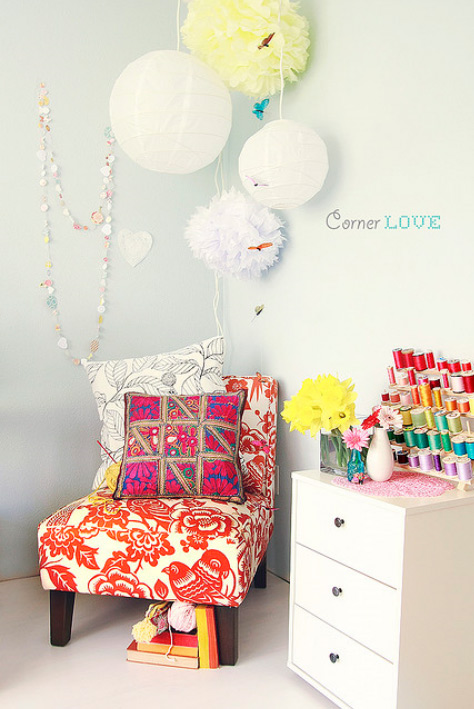 Corner Love by Debee Campos on Flickr Corner Love by Debee Campos on Flickr
Do you wonder what you should blog about? Do you want to know how to get your readers interested in your art and how to pull in your target market?
I constantly get asked about this stuff. And, here are the 5 blog topics that I always recommend:
1. How you became an artist.
Your blog readers want to know more about you, especially if they read your blog regularly. Knowing why and how you became an artist helps your readers feel more connected to you which also means they’re going to be more likely to buy from you.
So, what’s the story? Did you always know that you were meant to be an artist? Did people support you when you told them you wanted to be an artist or did they encourage you to get a “real” job? Did you transition from a paralegal to an artist after many years of making your art part-time?
It doesn’t matter what the story is—it just matters that you tell it. Once you’ve written it, consider including it on your “About” page, so it doesn’t get buried in your archives.
2. Your specialty and why you choose it.
If you’re a mixed media artist, how did that end up happening? When did you first learn about mixed media art and why did you fall in love with it? If you’re a sculptor, what led you down that path?
Talk about the different types of art that you’ve attempted and why you chose watercolor painting, fiber art, or photography. Tell the journey you took to find the type of art that makes your heart sing.
3. The story behind a piece of art.
This is something you should do over and over.
Often, artists ask me how to write product descriptions that will appeal to their target markets. One of the main tips I tell them is to include a small piece of the story behind the piece of art in the product description. Now, you don’t want to include five paragraphs on why you painted a bridge in the product description. You’d just want to include the gist of it. But, you could include the 5 paragraph story in a blog post.
If you do this, you should link to where your readers can purchase the piece of art. You should also link to the story in the product description in case potential customers are interested in reading more.
4. Your inspiration.
Readers and potential customers want to know where you draw inspiration. This is another post that will make your readers feel more connected to you and your work. You could break this down into a series of posts: People that Inspire My Art, Places that Inspire My Art, Things that Inspire My Art, and Colors that Inspire My Art.
Include pictures of art and links to where it can be purchased with each post.
5. Your creative process.
People who appreciate art are often fascinated by the artist’s creative process. Show pictures of your art in stages and explain your process or show a fast moving video of you making a piece of art. This helps your readers feel more connected, but it also shows them the intensity and time that goes into the art that you create.
________________________________________________________
 About April About April
April Bowles-Olin helps creative entrepreneurs turn their dreams into reality through her website, Blacksburg Belle, where she writes about marketing, blogging, and increasing business success. She uses her background in psychology to help creatives reach their goals, take charge of their inner critic, and build businesses around their dream lifestyles. April fell in love with art the day her mother handed her a box of brightly colored crayons, and believes that living your truth, creating daily, and loving fully leads to happiness.
Italiano
 Corner Love by Debee Campos on Flickr Corner Love by Debee Campos on Flickr
Ti chiedi di cosa dovresti scrivere nel tuo blog? Vuoi sapere come far si che i tuoi lettori siano interessati alla tua arte e come attirare il tuo target di mercato?
Queste cose mi vengono chieste di continuo. Ed ecco qui i 5 argomenti che io raccomando sempre:
1. Come sei diventato un artista.
I lettori del tuo blog vogliono sapere di più su di te, specialmente se leggono il tuo blog regolarmente. Sapere perché e come sei diventato un artista aiuta i tuoi lettori a sentirsi più connessi a te, e questo significa anche che saranno anche più propensi ad acquistare da te.
Quindi, qual è la storia? Hai sempre saputo che saresti diventato un artista? Le persone ti hanno supportato quando hai detto loro che volevi essere un artista o ti incoraggiavano ad avere un lavoro “vero”? Sei passato da un lavoro tradizionale a quello di artista dopo aver fatto per molti anni l’artista part-time?
Non importa quale sia la storia – l’importante è che la racconti. Una volta che l’hai scritta, considera l’idea di inserirla nella tua “About” page (la pagina “chi sono/cosa faccio”), così che non sparisca nei tuoi archivi.
2. La tua specialità e perché l’hai scelta.
Se sei un artista che utilizza materiali differenti, come sei arrivato a questa scelta? Quando è stata la prima volta che hai imparato l’utilizzo di quei materiali mescolati insieme e perché te ne sei innamorato? Se sei uno scultore, cosa ti ha portato su quella strada?
Parla dei differenti tipi di arte a cui ti sei avvicinato e perché hai scelto la pittura ad acquarelli, la lavorazione dei filati, o la fotografia. Racconta del viaggio che hai intrapreso per trovare il tipo di arte che ti fa cantare il cuore.
3. La storia dietro ad una creazione artistica.
Questo è qualcosa che dovresti fare più e più volte.
Spesso, gli artisti mi chiedono come scrivere descrizioni di prodotti rivolti ai loro target di mercato. Una delle principali regole che dico loro è di includere nella descrizione un piccolo pezzo della storia che sta dietro alla realizzazione di quel prodotto artistico. Ora, non devi includere nella descrizione cinque paragrafi del perché hai dipinto un ponte. Dovresti giusto riassumerne il senso. Però puoi includere la storia di 5 paragrafi in un post del blog.
Se lo fai, dovresti linkare alla pagina in cui i tuoi lettori possono acquistare il prodotto. Dovresti anche linkare la storia nella descrizione del prodotto nel caso in cui i potenziali clienti siano interessati a saperne di più.
4. La tua ispirazione.
I lettori e i potenziali clienti vogliono sapere da dove prendi ispirazione. Questo è un’altro post che farà sentire i tuoi lettori più connessi a te e al tuo lavoro. Potresti anche suddividerlo in una serie di posts: Persone che ispirano la mia arte, Posti che ispirano la mia arte, Cose che ispirano la mia arte, e Colori che ispirano la mia arte.
Includi immagini dei tuo prodotti artistici e aggiungi in ogni posts i links a dove possono essere acquistati.
5. Il tuo processo creativo.
Le persone che apprezzano l’arte sono spesso affascinate dal processo creativo dell’artista. Mostra delle foto delle fasi di creazione di un prodotto artistico e spiega il processo o mostra un video velocizzato di te mentre crei. Questo oltre ad aiutare i tuoi lettori a sentirsi più connessi, mostra loro anche l’intensità e il tempo di cui necessiatano le tue creazioni per essere realizzate.
________________________________________________________
 Chi è April Chi è April
April Bowles-Olin aiuta gli imprenditori creativi a far diventare i loro sogni realtà attraverso il suo sito, Blacksburg Belle, dove scrive di marketing, blogging, e di come aumentare il successo della vostra attività. Usa il suo background in psicologia per aiutare i creativi a raggiungere i loro obiettivi, a prendere atto del loro senso critico, e costruire un’attività plasmata sullo stile di vita che sognano. April si è innamorata dell’arte il giorno in cui sua madre le ha messo in mano una scatola di vivaci matite colorate, e crede che vivere la propria verità creando quotidianamente e amando pienamente, porti alla felicità.
By Irene Zuccarello, on February 23rd, 2011
English
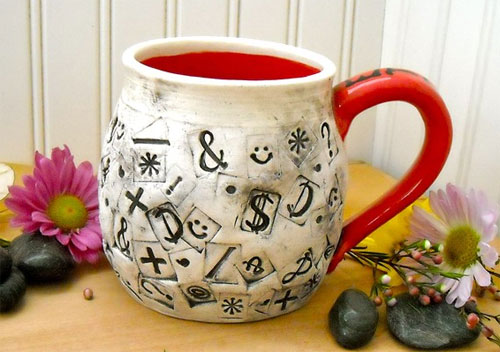 Etcetera Mug by loveartworks on Etsy Etcetera Mug by loveartworks on Etsy
What the heck do I put in my email newsletter?
Consulting clients and readers ask me this question all the time.
Since, I’ve already made a case for sending a weekly email newsletter, told you how to do it under 30 minutes, and given you methods to get more subscribers, I thought I’d give you some ideas on what to actually include.
Remember: I recommend you set up your email newsletter so you only add one new thing each week. Here are 45 ideas for that new thing:
1. The story behind your business.
2. Pictures of your art studio or creative space.
3. Coupon to get a discount in your online shop.
4. List of craft shows you’ll be selling at over the next year.
5. Pictures of your craft show booth.
6. Basic tutorial.
7. The first paragraph of a blog post you published and a link to read the rest on your blog.
8. Contest announcement.
9. New product line launch announcement.
10. Pictures of your art.
11. The story of how you became an artist.
12. Answer a blog reader’s question.
13. Ask readers to submit questions and answer them in your next newsletter.
14. Review a product.
15. Highlight a customer.
16. Highlight another artist.
17. Mini interview with someone in your niche.
18. List of tips that will help your readers solve a problem.
19. Your opinion on a controversial topic in your niche.
20. Pictures and the story behind your favorite handmade item.
21. A list of books that have inspired your work.
22. A list of artists that have inspired your work.
23. Survey.
24. Pictures of one of your handmade products from start to finish.
25. Pictures of your products wrapped in pretty packaging.
26. A list of bloggers that inspire you and links to their blogs.
27. The story behind your business name.
28. Sale announcement.
29. Tips for buying handmade products.
30. Photographs that inspire you.
31. Your monthly goals.
32. Your creative process.
33. Pictures from your art journal.
34. The story and inspiration behind a specific product.
35. A list of art supplies you use regularly.
36. Your daily routine.
37. A lesson you’ve learned since selling your handmade products.
38. What you’re passionate about.
39. How you get past creative blocks.
40. Preview of a new line of products.
41. Tips for someone who’s a beginner in your area of expertise.
42. Your business updates.
43. A freebie or giveaway.
44. Pictures of you creating.
45. Values and beliefs that inspire your work.
________________________________________________________
 About April About April
April Bowles-Olin helps creative entrepreneurs turn their dreams into reality through her website, Blacksburg Belle, where she writes about marketing, blogging, and increasing business success. She uses her background in psychology to help creatives reach their goals, take charge of their inner critic, and build businesses around their dream lifestyles. April fell in love with art the day her mother handed her a box of brightly colored crayons, and believes that living your truth, creating daily, and loving fully leads to happiness.
Italiano
 Etcetera Mug by loveartworks on Etsy Etcetera Mug by loveartworks on Etsy
Che cavolo scrivo nella mia email newsletter?
I clienti e i lettori che mi consultano mi fanno sempre questa domanda.
Dal momento che ho già scritto un articolo sul perchè è importante spedire una newsletter settimanale , ti ho detto come farlo in meno di 30 minuti, e ti ho dato dei metodi per avere più iscritti, ora ho pensato di darti delle idee su che cosa metterci dentro.
Ricorda: Ti consiglio di impostare la tua newsletter in modo da aggiungere una sola cosa nuova ogni settimana. Di seguito 45 idee per questa “nuova cosa” da inserire:
1. La storia che sta dietro alla tua attività.
2. Fotografie del tuo studio o spazio creativo.
3. Coupon/codice per avere uno sconto nel tuo negozio online.
4. Lista delle fiere in cui venderai i tuoi prodotti durante l’anno.
5. Foto della tua bancarella/stand.
6. Un tutorial di base.
7. Il primo paragrafo di un articolo che hai pubblicato con il relativo link per leggerlo sul tuo blog.
8. L’annuncio di un contest.
9. L’annuncio di una nuova linea di prodotti.
10. Fotografie della tua arte/creazioni.
11. La storia di come sei diventato un artista.
12. La risposta a una domanda fatta da un lettore del tuo blog.
13. Chiedi ai lettori di fare delle domande e rispondi ad esse nella tua prossima newsletter.
14. Recensisci un prodotto.
15. Metti in luce un cliente.
16. Metti in luce un’altro artista.
17. Una piccola intervista a qualcuno nella tua nicchia.
18. Lista di suggerimenti che aiuteranno i tuoi lettori a risolvere un problema.
19. La tua opinione su un argomento controverso riguardante la tua nicchia.
20. Delle foto e la storia che stanno dietro al tuo prodotto handmade preferito.
21. Una lista di libri che hanno ispirato il tuo lavoro.
22. Una lista di artisti che hanno ispirato il tuo lavoro.
23. Un sondaggio.
24. Immagini della creazione di un tuo prodotto handmade dall’inizio alla fine.
25. Foto dei tuoi prodotti incartati con un bel packaging.
26. Una lista di bloggers che ti ispirano e i links ai loro blogs.
27. La storia che sta dietro al nome della tua attività.
28. Annuncio di saldi.
29. Suggerimenti per acquistare prodotti handmade.
30. Fotografie che ti ispirano.
31. I tuoi obiettivi mensili.
32. Il tuo processo creativo.
33. Immagini dal tuo art journal.
34. La storia e l’ispirazione che stanno dietro ad un tuo specifico prodotto.
35. Una lista di rifornimenti/materiali che usi regolarmente.
36. La tua routine quotidiana.
37. Una lezione che hai imparato da quando vendi i tuoi prodotti artigianali.
38. Ciò che ti appassiona.
39. Come hai superato i tuoi blocchi creativi passati.
40. Un’anteprima di una nuova linea di prodotti.
41. Suggerimenti per qualcuno che è un principiante nella tua area di competenza.
42. Aggiornamenti sulla tua attività/il tuo business.
43. Un omaggio o un giveaway.
44. Fotografie di te mentre crei.
45. Valori e convinzioni che ispirano il tuo lavoro.
________________________________________________________
 Chi è April Chi è April
April Bowles-Olin aiuta gli imprenditori creativi a far diventare i loro sogni realtà attraverso il suo sito, Blacksburg Belle, dove scrive di marketing, blogging, e di come aumentare il successo della vostra attività. Usa il suo background in psicologia per aiutare i creativi a raggiungere i loro obiettivi, a prendere atto del loro senso critico, e costruire un’attività plasmata sullo stile di vita che sognano. April si è innamorata dell’arte il giorno in cui sua madre le ha messo in mano una scatola di vivaci matite colorate, e crede che vivere la propria verità creando quotidianamente e amando pienamente, porti alla felicità.
By Irene Zuccarello, on February 17th, 2011
English
 Image by tinytoadstool from dadaya Image by tinytoadstool from dadaya
Sending out a weekly email newsletter is an absolute must.
If you have an online business and you’re not willing to spend 30 minutes on this each week, you’re missing out on a direct way to sell to your target market.
After you’ve decided to send out a newsletter, you’ve got to get subscribers. Setting up an email newsletter subscription isn’t enough. You know that saying, “If you build it, they will come.” Well, it doesn’t apply here. You’ve got to work for it.
So, let’s roll up our sleeves and get to work.
Add an Opt-in Form to Your Website/Blog
The first step you need to take is to add an opt-in form to the sidebar of your website or blog. Here’s the critical tip: it has to be above the fold.
If you bury your email newsletter opt-in under your blog roll, contact information, and other stuff cluttering your sidebar, you’ll miss out on a lot of subscribers.
Don’t make it a tiny little form with no title. Your readers have to know what it is, how to fill it out, and what they’ll get from it. Also, don’t ask for more than a name and email address. Why? Research has proven that the more information you require, the less likely people will sign up.
Call Your Readers and Customers to Action
This is pretty simple and it really works. Just ask.
At the end of your blog posts, encourage your readers to sign up for your email newsletter. In one or two sentences, let them know what they’ll get if they sign up. For instance, you might say, “Sign up for my weekly email newsletter to get product updates, coupons and discounts, and an insider look into my business.”
Whatever you promise your newsletter subscribers, you need to deliver. If you tell them that they’ll be the first to know about all of your sales, make sure they are the first to know. Trust is the hardest thing to build with potential customers—and it’s the easiest thing to lose.
If you send out thank you emails to your customers once they’ve made a purchase, just add a line in the email encouraging your customers to sign up to receive your weekly newsletter in those thank you emails.
Use social media to call people to action. A couple hours before you send out your email newsletter, send out a tweet calling people to action. You might say, “Sending out our weekly newsletter in 2 hours. Sign up here if you want in on this awesomeness.” And, post a link to your newsletter opt-in on your Facebook fan page.
Add a “Cookie”
Give your readers and fans a reason to sign up for your newsletter by adding a “cookie.” You know when you were a little kid and your parents rewarded you with a cookie. This is the same kinda thing. People no longer give away their email address easily—because we all get way too much spam.
So, you need to make it worth it for your readers. A cookie could be a video they get access to, a series of articles, a tutorial, an inside look at your art studio, or anything else that your customers would be interested in getting. When they sign up to receive your newsletter, they get instant access to the “cookie.”
Once you add this little treat, you’ll definitely see an increase in subscribers, especially if you peak their curiosity. For instance, if you add a video tour of your art studio, you might say something like, “Sign up for my email newsletter to receive a video tour of my art studio. You won’t believe how I organize my supplies!”
You can market your email newsletter and attract your ideal customers to sign up for it by doing those 3 things.
________________________________________________________
 About April About April
April Bowles-Olin helps creative entrepreneurs turn their dreams into reality through her website, Blacksburg Belle, where she writes about marketing, blogging, and increasing business success. She uses her background in psychology to help creatives reach their goals, take charge of their inner critic, and build businesses around their dream lifestyles. April fell in love with art the day her mother handed her a box of brightly colored crayons, and believes that living your truth, creating daily, and loving fully leads to happiness.
Italiano
 Image by tinytoadstool from dadaya Image by tinytoadstool from dadaya
Spedire una newsletter settimanale è un must assoluto.
Se hai un’attività online e non sei disposto a spendere 30 minuti in questo ogni settimana, stai perdendo un modo diretto di vendere al tuo target di mercato.
Dopo aver deciso di spedire le tue newsletter, devi avere degli iscritti. Preparare un’iscrizione per la newsletter non è sufficiente. Lo conosci quel detto, “Se lo costruisci, verranno.” Beh, qui non funziona così. Devi lavorarci.
Perciò, rimbocchiamoci le maniche e mettiamoci al lavoro.
Aggiungi un form di iscrizione al tuo Website/Blog
Il primo passo da fare è aggiungere un form/modulo alla barra laterale del tuo sito web o blog. Questo è il punto critico: deve rientrare nella schermata iniziale del sito.
Se seppellisci il tuo modulo d’iscrizione alla newsletter sotto al tuo blog roll, alle informazioni di contatto, e altre cose che riempiono la tua barra laterale, perderai molti iscritti.
Non rendere il modulo minuscolo e senza titolo. I tuoi lettori devono sapere cos’è, come compilarlo, e cosa riceveranno da quell’ iscrizione. E poi, non chiedere più di un nome e un indirizzo email. Perché? Le ricerche hanno provato che più informazioni richiedi, minori sono le probabilità che si iscrivano.
Chiama all’azione i tuo lettori e clienti
Questo è abbastanza semplice e funziona davvero. Devi solo chiedere.
Alla fine dei tuoi articoli nel blog , incoraggia i tuoi lettori a iscriversi per ricevere la tua email newsletter. In una o due righe fa sapere loro cosa riceveranno se si iscrivono. Per esempio, potresti dire “Iscriviti alla mia newsletter settimanale per ricevere aggiornamenti sui miei prodotti, cupon e sconti, e uno sguardo ravvicinato alla mia attività.
Qualunque cosa tu prometta ai tuoi iscritti, è necessario sia spedita. Se dici loro che saranno i primi a sapere dei saldi, assicurati che siano i primi. La fiducia è la più difficile cosa da costruire con i tuoi potenziali clienti – ed è la più facile cosa da perdere.
Se spedisci delle email di ringraziamento ai tuoi clienti una volta che hanno effettuato un acquisto, aggiungi una riga nella email incoraggiandoli a iscriversi per ricevere la tua newsletter settimanale.
Usa i social media per richiamare le persone all’azione. Un paio di ore prima di spedire la tua newlsetter, pubblica un tweet che inviti le persone all’azione. Potresti dire “Tra due ore spediremo la nostra email newsletter settimanale. iscriviti qui se vuoi ricevere le nostre chicche.” E pubblica un link al tuo modulo di iscrizione per la newsletter nella tua pagina fan di Facebook.
Aggiungi un “Cookie” (biscottino)
Da ai tuoi lettori e fans una ragione per iscriversi alla tua newsletter aggiungendo un “biscottino”. Sai quando eri bambino e i tuoi genitori ti premiavano con un biscottino. Questa è la stessa cosa. Le persone non danno più i loro indirizzi email facilmente – perché a tutti noi arriva un sacco di spam.
Perciò hai bisogno di far si che ne valga la pena. Un biscottino potrebbe essere un video a cui possono avere accesso, una serie di articoli, un tutorial, uno sguardo privilegiato allo studio dove crei la tua arte, o qualunque altra cosa che i tuoi lettori possono avere interesse ad avere. Quando si iscrivono alla tua newsletter, hanno accesso immediato al “biscottino”.
Una volta che hai aggiunto questo piccolo regalo, avrai sicuramente un incremento di iscritti, specialmente se punti alla loro curiosità. Per esempio, se aggiungi un video tour del tuo studio, potresti dire qualcosa come “Iscriviti alla mia newsletter per ricevere un video tour del mio studio. Non puoi immaginare come organizzo le mie forniture!”
Puoi creare la newsletter per il tuo target di mercato e invogliare i tuoi clienti ideali a iscriversi per riceverla, facendo queste 3 cose.
________________________________________________________
 Chi è April Chi è April
April Bowles-Olin aiuta gli imprenditori creativi a far diventare i loro sogni realtà attraverso il suo sito, Blacksburg Belle, dove scrive di marketing, blogging, e di come aumentare il successo della vostra attività. Usa il suo background in psicologia per aiutare i creativi a raggiungere i loro obiettivi, a prendere atto del loro senso critico, e costruire un’attività plasmata sullo stile di vita che sognano. April si è innamorata dell’arte il giorno in cui sua madre le ha messo in mano una scatola di vivaci matite colorate, e crede che vivere la propria verità creando quotidianamente e amando pienamente, porti alla felicità.

|
Follow IB

>> To receive IB's posts straight in your inbox just click here!
Featured artists Featured on IB? Show it to your readers with this digital sticker!
|
 (Foto credit: CasaFacile)
(Foto credit: CasaFacile)  (Foto credit: Ilaria Chiaratti)
(Foto credit: Ilaria Chiaratti)
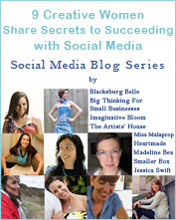








 Silk screen printed poster –
Silk screen printed poster –  About April
About April 1.
1.  Photo via
Photo via  Corner Love by
Corner Love by  Etcetera Mug by
Etcetera Mug by  Image by
Image by 

